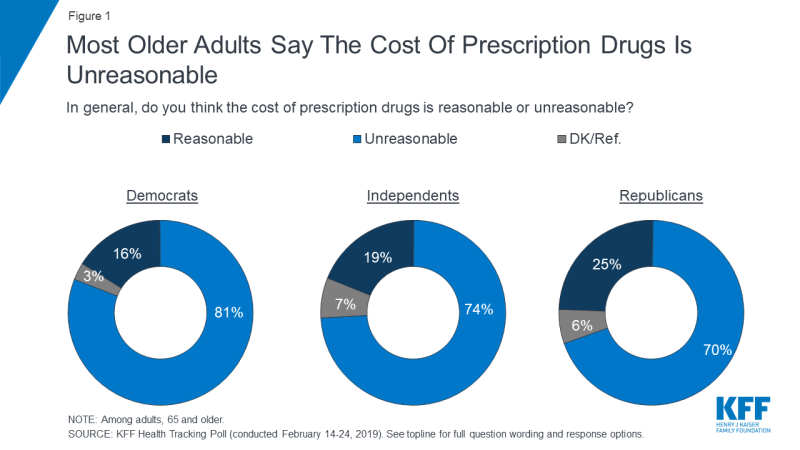Data Note: Prescription Drugs and Older Adults
With continued attention from policymakers on prescription drug costs, a 2019 KFF Health Tracking Poll took a deep dive into the views of Americans on a variety of topics related to prescription drugs with special attention paid to the experiences and attitudes of older adults, defined here as people ages 65 and older. Older adults’ experiences with prescription medications can vary significantly based on their health status, how many prescription drugs they are currently taking, and other demographic variables like household income. This data note explores the varied experiences of older adults across such different demographic groups. With most older adults (83%) reporting that they currently have insurance that helps them pay for prescription drugs1, this data note also explores how older adults chose their prescription drug plans and what they prioritize in their coverage. In addition, it explores older adults’ views on several prescription drug policy options currently being discussed by policymakers.
Prescription Drug Use and Affordability Issues
Nearly nine in ten (89%) adults 65 and older report they are currently taking any prescription medicine. This compares to three-fourths of 50-64 year olds who report taking prescription drugs, half (51%) of 30-49 year olds, and four in ten (38%) 18-29 year olds. Older adults are also more likely than their younger counterparts to be taking multiple prescription medications. More than half of adults 65 and older (54%) report taking four or more prescription drugs compared to one-third of adults 50-64 years old (32%) and about one in ten adults 30-49 (13%) or 18-29 (7%).
While a majority of older adults have prescription drug coverage through Medicare Part D, which is Medicare’s voluntary prescription drug benefit, most older adults (76%) think the cost of prescription drugs is unreasonable. This viewpoint is consistent across party identification, with majorities of Democrats (81%), independents (74%), and Republicans (70%) saying the cost of prescription drugs is unreasonable.
In addition, one-fourth of older adults (23%) who take prescription drugs say it is difficult to afford their prescription drugs, including about one in ten (8%) saying it is “very difficult.” As is true among the public as a whole, there are certain groups of older adults who are much more likely to report difficulty affording medications, including those who report being in either “only fair” or “poor” health (45%), whose household income is less than $30,000 annually (34%), and who take four or more prescriptions (28%). These factors are inter-related, as those who are in relatively poor health are also more likely to be taking four or more prescriptions and spending at least $25 a month on their medications.
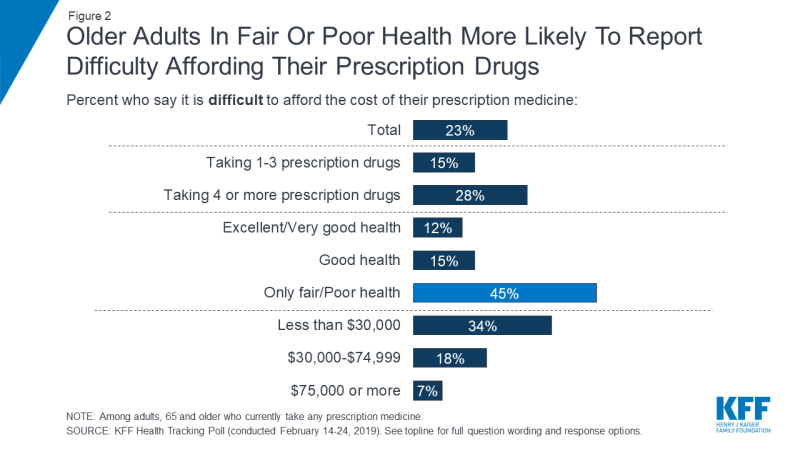
Figure 2: Older Adults In Fair Or Poor Health More Likely To Report Difficulty Affording Their Prescription Drugs
About one in five older adults (21%) say they did not take their medicines as prescribed at some point in the past year because of the cost. This includes those who report that, due to costs, they haven’t filled a prescription (12% of total older adults), took an over-the counter drug instead (11% of total), or cut pills in half or skipped a dose (8% of total).
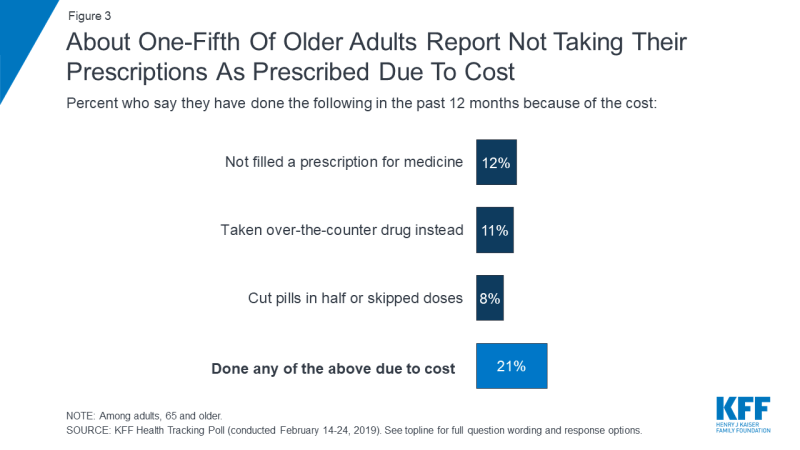
Figure 3: About One-Fifth Of Older Adults Report Not Taking Their Prescriptions As Prescribed Due To Cost
Notably, among those who report not taking their medicines as prescribed, slightly more than half (53%) say they didn’t tell their doctor or health care provider (11% of the total) and one-fifth (22%) of this group say their condition got worse as a result of not taking their prescription as recommended (5% of total).
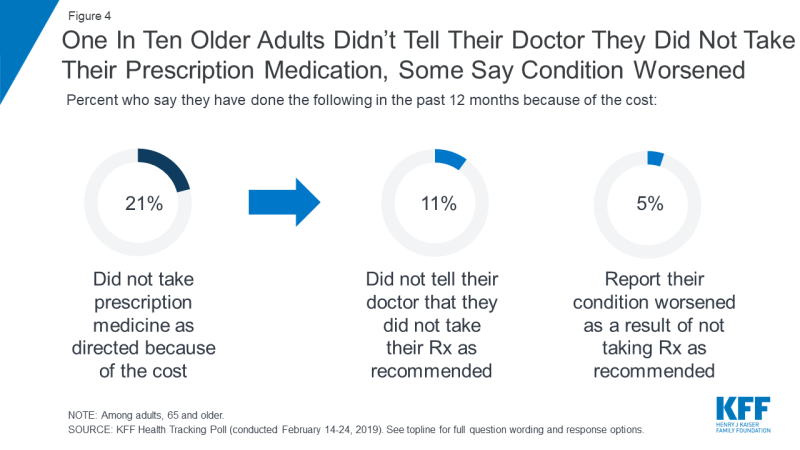
Figure 4: One In Ten Older Adults Didn’t Tell Their Doctor They Did Not Take Their Prescription Medication, Some Say Condition Worsened
Less Than Half Of older adults report discussing the cost of Their prescriptions with their doctor or pharmacist
The KFF polling finds that older adults are more likely to report discussing safety concerns than cost issues with their doctors and pharmacists when getting a new prescription. Seven in ten older adults (72%) say they usually talk to their doctor about the safety and potential side effects of the drug when their doctor writes a prescription for a drug they haven’t taken before. In contrast, around four in ten older adults (43%) say they usually talk to their doctor about whether there is a less expensive alternative, and just over one-third (36%) talk about the cost they will have to pay for the new medication.
Similarly, while half of older adults say they usually talk to their pharmacist about the safety and potential side effects of a new prescription drug, fewer (32%) say they talk to their pharmacist about whether there is a less expensive alternative available. About four in ten (43%) say they talk their doctor about the same thing.
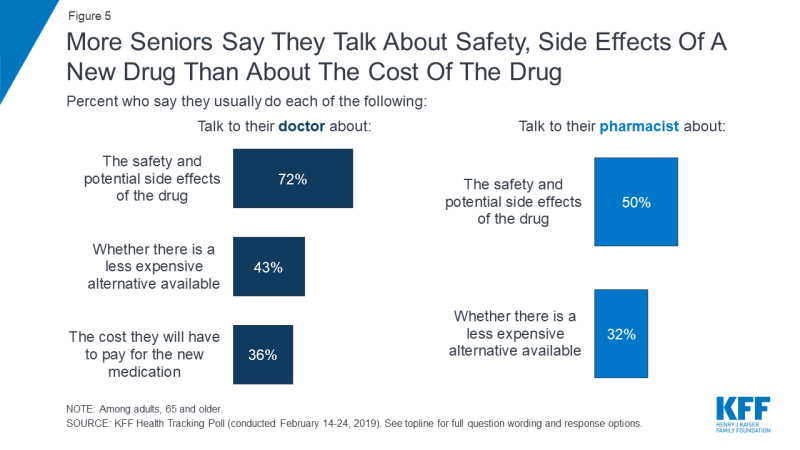
Figure 5: More Seniors Say They Talk About Safety, Side Effects Of a New Drug Than About The Cost Of The Drug
Older adults who report difficulty affording their prescriptions are no more likely to report talking to their doctor or their pharmacist about drug costs than those who report no difficulty affording their medications.
Experiences with Prescription Drug Coverage
People with prescription drug coverage under Medicare Part D are encouraged to compare plans each year to find coverage that best meets their individual needs, based on the specific drugs they take. For 2019, Medicare beneficiaries could choose from among 27 stand-alone Medicare Part D prescription drug plans, and 21 Medicare Advantage prescription drug plans, on average.
Less than four in ten older adults report comparing plan premiums (36%) or co-pays for prescription drugs they were currently taking (36%), and about three in ten (28%) say they compared which prescription drugs were covered by each of the different drug plans. Overall, about half (47%) of older adults who have prescription drug coverage say they did some comparison shopping when choosing their current prescription drug plan.
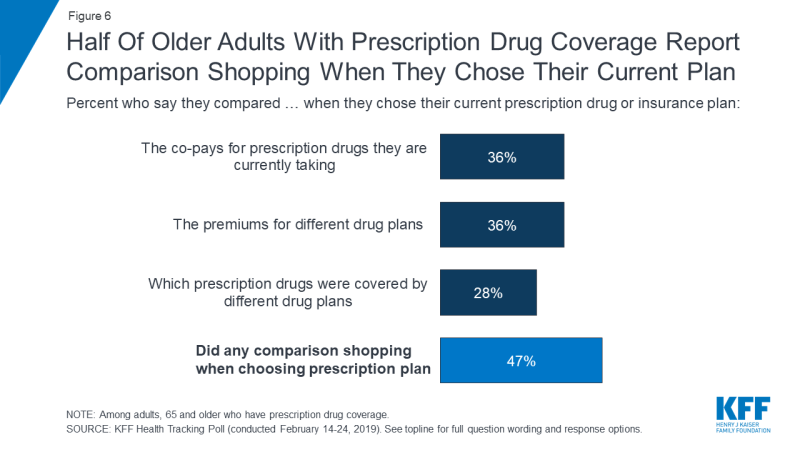
Figure 6: Half Of Older Adults With Prescription Drug Coverage Report Comparison Shopping When They Chose Their Current Plan
Some older adults report various problems accessing prescription drugs through their plan
Overall, nearly half (45%) of older adults with prescription drug coverage say they have experienced various problems accessing prescription drugs through their drug plan in the past 12 months. Nearly three in ten older adults (28%) report that their plan did not cover a drug prescribed by their doctor. Nearly one-fourth (23%) report that their plan required them to try a less expensive drug before they could get a more expensive drug initially prescribed by their doctor—a utilization management tool known as step therapy—and one in five (21%) report having to wait more than two days to get a prescription filled due to prior authorization requirements by their drug plan.
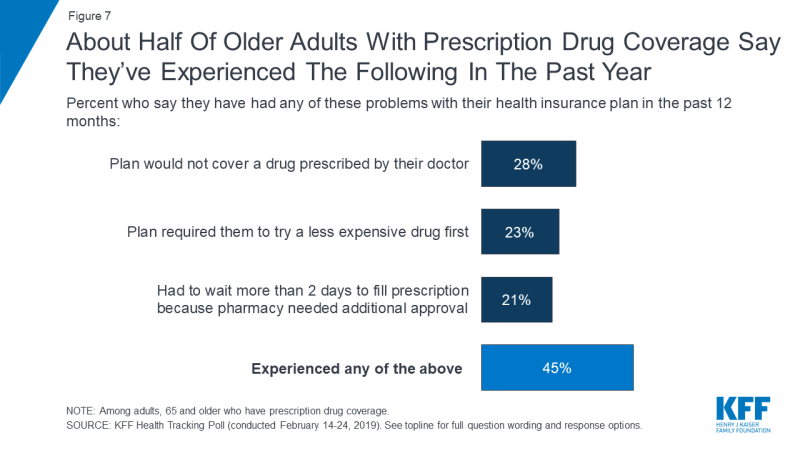
Figure 7: About Half Of Older Adults With Prescription Drug Coverage Say They’ve Experienced The Following In The Past Year
Certain groups of older adults were more likely than others to report experiencing difficulty with their prescription drug coverage in the past 12 months, including more than half of those with a household income of less than $30,000 a year and just over half of those taking four or more prescription drugs.
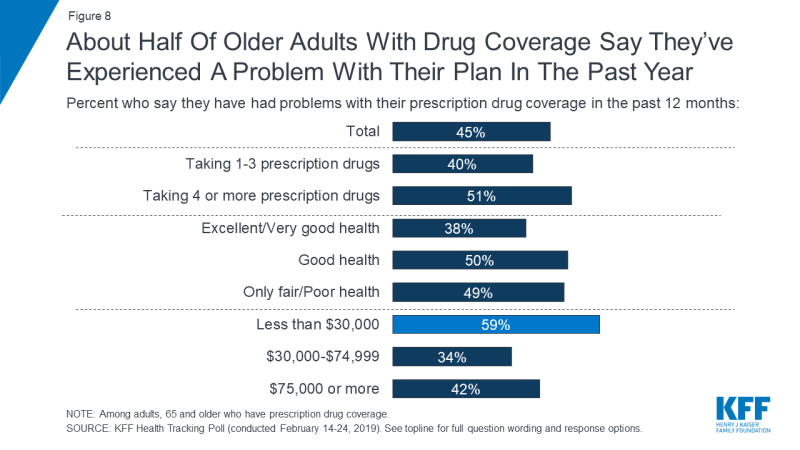
Figure 8: About Half Of Older Adults With Drug Coverage Say They’ve Experienced A Problem With Their Plan In The Past Year
Few older adults report using patient assistance programs or other types of discounts
One-fifth of older adults say they have received a discount on a prescription drug in the past year, either through a coupon, a co-pay card, drug company patient assistance program, or some other type of discount. Those who report difficulty affording their medications are no more likely than those who do not report difficulty affording their medications to say they have received a discount on a prescription drug in the past year (25% compared to 20%, respectively).
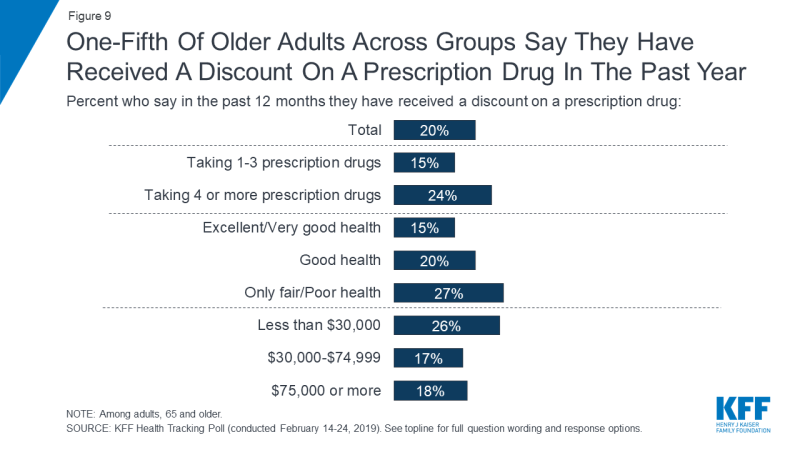
Figure 9: One-Fifth Of Older Adults Across Groups Say They Have Received A Discount On A Prescription Drug In The Past Year
When older adults with prescription drug coverage were asked what feature of their coverage is more important to them, a larger share say having a lower co-pay at the pharmacy is more important to them than paying a lower premium each month (51% versus 35%). This finding may reflect the greater frequency of payment for prescription drug co-pays versus monthly premiums. In addition, monthly Part D premiums have been relatively stable in recent years, which may help to lessen concerns about premium levels among older adults.
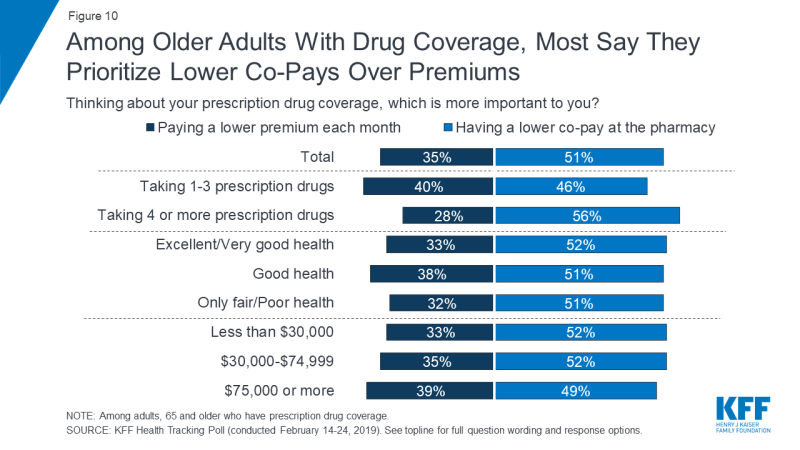
Figure 10: Among Older Adults With Drug Coverage, Most Say They Prioritize Lower Co-Pays Over Premiums
Majorities of Older Adults Support Various Actions Aimed at Keeping Costs Down
Unlike many other health policies that divide partisans, majorities of older adults across party identification favor many of the policy proposals included in the KFF poll, including recent Trump administration proposals like international reference pricing, Democratic proposals to allow the federal government to negotiate drug prices, and bipartisan proposals to add a cap on out-of-pocket spending to Part D. Each of these policy proposals is supported by large majorities of Democrats, independents, and Republicans.
| Table 1: Majorities Of Older Adults Across Partisans Say They Favor Medicare Drug Negotiations, Reference Pricing, And Placing Limits On Spending To Lower Drug Costs | ||||
| Percent of older adults who favor each of the following actions to keep prescription drug costs down: | Total | Democrats | Independents | Republicans |
| Allowing the gov’t to negotiate with drug companies to get a lower price for people with Medicare | 82% | 88% | 79% | 81% |
| Placing an annual limit on out-of-pocket drug costs for people with Medicare | 68 | 68 | 67 | 73 |
| Lowering what Medicare pays based on amounts in other countries | 60 | 61 | 61 | 58 |
| Allowing Medicare drug plans to put more restrictions on use of certain drugs | 45 | 48 | 46 | 42 |
| Allowing Medicare drug plans to exclude more drugs | 24 | 28 | 21 | 20 |
Fewer older adults favor allowing Medicare to restrict access to certain prescription medications such as allowing Medicare drug plans to put more restrictions on the use of certain drugs (45%) or allowing these plans to exclude more drugs (24%).

